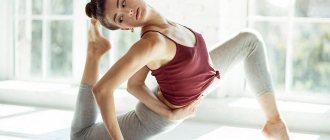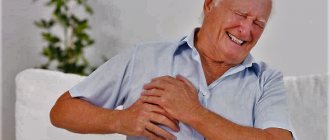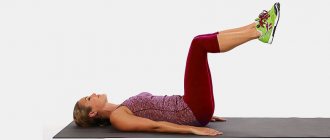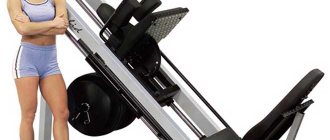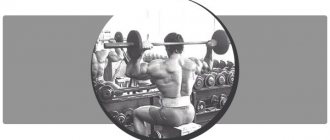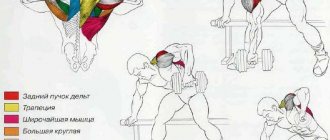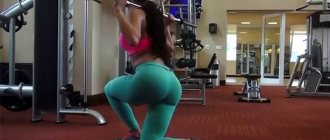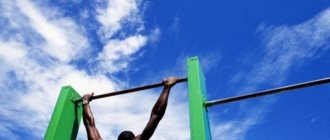general characteristics
Bubnovsky’s technique is a set of trainings that are based on kinesitherapy (a separate direction of physical therapy (physical therapy), based on basic medical disciplines and aimed at the psychophysical well-being of the patient). Kinesitherapy literally means “motion therapy.” The complex is individual. Individuality depends on a specific myofascial examination (manual and visual assessment of ligaments, joints and muscles). The assessment focuses on the range of motion of individual joints and the condition of the muscles.
Some deep muscles (for example, the cervical spine), rarely involved in the exercises of classical physical therapy programs (physical therapy) and in everyday life, are developed thoroughly and purposefully using this technique. The muscle frame is strengthened. In addition, the physical activity of this course is accompanied by breathing exercises, cryotherapy, and massage.
Thanks to Dr. Bubnovsky’s exercises, you can strengthen the muscular frame of the neck
Dr. Bubnovsky created a special simulator for quickly relieving pain and restoring mobility. The simulator is applicable in outpatient settings and is safe. It is a simple design equipped with movable blocks, arches and weights (providing decompression and anti-gravity functions) that relieve stress on the spine. At the same time, the muscles actively work.
Dr. Bubnovsky's centers are located throughout the country. There they teach the technique and order of performing individually selected exercises. After training, the patient does everything at home, which is another advantage of this technique.
Training can be carried out in several modes. A gentle regimen is used for exacerbation of inflammatory processes and severe pain. The recovery mode is suitable for rehabilitation purposes, and the training mode is suitable as additional therapeutic measures.
Causes and symptoms of cervical osteochondrosis
The main goal is to move the body and improve blood circulation, since with osteochondrosis all the back muscles are stiff. Bubnovsky's technique is based on breathing work, diet and water procedures. Osteochondrosis of the spine causes severe pain in a person. People who lead a sedentary lifestyle have the greatest risk of developing this disease, so it is important to start moving and exercising daily. Features of the method:
- Depending on the capabilities of the human body, an individual complex is selected.
- The most immobile muscles are activated and strengthened.
- The treatment uses special breathing exercises, massage and cryotherapy.
The cervical sector of the spine is the most mobile available. The disruption of its functions is caused by the process of degradation, thinning, cracking of intervertebral discs, disruption of lymph flow and blood circulation in the cervical region, and pinching of nerve endings.
The causes of cervical osteochondrosis are:
- Physical inactivity.
- Metabolic disorder.
- Unbalanced diet.
- Salt deposits in the cervical area.
- Work related to driving a vehicle and constantly being in a sitting position.
- Hormonal imbalances.
- Injuries.
- Heredity.
- Rheumatism.
- Cooling of the neck area.
With cervical osteochondrosis, dizziness and pain in the temples are often observed.
Due to impaired vascular metabolism, dizziness leading to fainting, numbness of the limbs, cervical region, and tingling between the shoulder blades are observed. A distinctive symptom is the inability to fully turn the head; the process is accompanied by a crunching sound.
Experienced doctor Sergei Mikhailovich Bubnovsky is convinced that kinesiotherapy is the future. The doctor has developed a series of workouts to get rid of cervical osteochondrosis, which include the postulates of movement therapy.
Dr. Bubnovsky’s exercises give positive results, especially at the initial stage of cervical osteochondrosis. Therapeutic exercises are used in conjunction with drug therapy. The technique has been tested on a huge number of patients with cervical osteochondrosis and has been refined over the years.
With cervical osteochondrosis, dizziness and pain in the temples are often observed.
Bubnovsky’s gymnastics has several differences from standard therapeutic exercises.
Dr. Bubnovsky has developed his own training method, which is capable of activating the body's defenses.
Features of the method:
- Individual approach.
- Strengthening the muscle corset at a deep level.
- A symbiosis of physical activity with breathing, as well as massage and cryotherapy.
- Versatility: exercises are suitable for treatment and prevention.
- Activation of the body's defenses.
A qualified neurologist first examines the patient and finds the focus of osteochondrosis. Then he develops an individual set of exercises for the back in order to eliminate the symptoms of cervical osteochondrosis. The effectiveness of this approach is an order of magnitude higher than that of general training. At the first stage, the exercises are performed in the treatment center of Dr. Bubnovsky.
Application
In the modern world, people are rapidly switching to physical inactivity. This leads to stagnant processes in the circulatory and lymphatic systems, so problems with the spine are a fairly pressing problem. There is another extreme - professional sports, which require thorough rehabilitation measures.
Exercises can be performed not only if you have osteochondrosis, but also with headaches and sleep disorders
The Bubnovsky method can be applicable both for pathologies affecting the skeleton and muscles, and for diseases of internal organs. This set of procedures and exercises is aimed at normalizing not only organ disorders, but also the psychological state of the patient. The exercises can be used under the following conditions.
- Osteochondrosis.
- Headache and neck pain (associated with compression of vertebral vessels).
- Sleep disorders (for example, insomnia associated with pain due to degenerative processes in the musculoskeletal system).
- High blood pressure.
- Vegetative-vascular syndrome, vegetative-vascular dystonia is a disorder of the ANS (autonomic nervous system) against the background of somatic or mental disorders due to organic damage to the central nervous system or hormonal changes. There may be general complaints such as tremors, sweating, redness.
- Decreased attention and memory impairment under conditions of constant physical inactivity. This is due to stagnant processes and increased load on the cervical spine.
Despite all the variety of applications of the course, this article focuses primarily on the use of kinesitherapy and its effect in osteochondrosis of the cervical region. Spasmed neck muscles add static load to the vertebral cartilage. The elasticity and other shock-absorbing properties of cartilage discs are reduced. The vessels and nerve endings passing in this area are injured, so the manifestations may correlate with disorders of the internal organs, for example, the vestibular apparatus. Prerequisites for ischemic and radicular symptoms arise. In advanced cases, the following symptoms may appear due to compression of the vertebral arteries:
- headache;
- flashing dots before the eyes;
- dizziness;
- deterioration of attention, memory;
- loss of consciousness;
- coordination problems.
The earlier the diagnosis of osteochondrosis is made, the more effective the treatment and the shorter the rehabilitation period. Timely use of kinesitherapy exercises reduces the risk of complications mentioned above. The load on the axial skeleton during these trainings does not increase, while the muscles are actively strengthened. This is the main difference from everyday physical activity. Kinesitherapy is very effective for the prevention of degenerative processes in this fragile department.
If you start kinesitherapy as early as possible, the effect will come much faster.
Bubnovsky’s training methodology: description and general information
- relieving muscle spasms;
- reducing the load on the spinal column;
- normalization of blood circulation;
- elimination of degenerative phenomena in cartilage and bone tissues.
It is important to change the way you live. Even after the treatment complex, long sitting positions in front of the computer can quickly return to the previous state.
Indications for implementation
The uniqueness of the complex is that there are practically no contraindications. It is used as an exercise for the neck, simply included in the complex of morning exercises.
Dr. Bubnovsky advises using the technique daily for the shoulder and neck areas to prevent the occurrence of osteochondrosis. After all, everyone knows that any disease is easier to prevent.
If signs have already appeared, then it is better to begin implementation as soon as possible. The following symptoms should alert you:
- pain when turning or tilting the head;
- strange crunch;
- dizziness;
- numbness of fingers;
- “withers” appearing on the back in the neck area;
- tension in the neck muscles.
These are the symptoms that accompany osteoporosis. Gymnastics for the neck according to Dr. Bubnovsky video.
You should not miss other recommendations to eliminate problems with the spine. Here are exercises for cervical osteochondrosis according to Bubnovsky, which can be repeated at any time of the day. But effective treatment will be if gymnastics is carried out in the morning or in the evening after work at the same time.
Important! If you hear a crunch when you tilt your head towards your shoulder, you already need Bubnovsky’s neck gymnastics.
Complex efficiency
You should not expect that treatment of cervical osteochondrosis according to Bubnovsky will give instant results. However, slight relief occurs after the first lesson:
- muscle stiffness disappears;
- neck movements are easier;
- crunching and pain in the spine in the neck area disappear;
- headache disappears;
- mood improves.
This alone is enough to understand that training for the muscles of the cervical spine should be carried out daily. It's hard in the first days. It will get easier every day. After all, it is necessary to eliminate the problem and consolidate a lasting result.
For whom it is contraindicated
Before starting Bubnovsky’s therapeutic exercises, it is advisable to consult a doctor. Aesculapians are well aware of their colleague’s methods, and they will definitely recommend what to pay attention to and what to refuse. In addition, there is a whole list of contraindications that cannot be ignored so as not to provoke a relapse of another problem.
Bubnovsky exercises are contraindicated:
- at high temperature;
- in the postoperative period;
- in the presence of infectious diseases;
- cardiac pathology;
- hypertension;
- oncology;
- pregnancy.
A good mood is an important factor in the fight against any pathology. Simple exercises for headaches can relieve them. This is why prior consultation is important.
Peculiarities
Despite the fact that Bubnovsky’s technique involves the use of an individual program, some recommendations, exercises and principles are universal. Firstly, exercises according to the method are not an isolated method of treatment: they are combined with classical treatment. The purpose of the technique is to strengthen the muscle corset and ligaments of the cervical region, which will contribute to the main course of treatment and improve the general condition of the patient. If you diligently follow the recommendations, the following results are possible.
- Relieving neck muscle spasms.
- Reducing the load on the axial skeleton.
- Improvement of trophism. Acceleration of excretion of tissue metabolic products.
- Slowing down degenerative processes.
- Reduction of inflammatory processes in tissues.
- Increased performance and quality of life as a result of pain relief.
Thanks to Dr. Bubnovsky’s exercises, the patient’s performance increases, pain and spasms go away
Bubnovsky’s technique does not give instant results. Like any course of treatment aimed at slowing down degenerative processes in the structures of the musculoskeletal system, a set of exercises requires patience and diligence. In addition, stopping only at this technique without self-massage and proper nutrition, which Dr. Bubnovsky recommends in addition to the course, may not give the desired results.
You cannot apply the technique yourself without prescribing a professional selection of an individual program and preliminary training.
For patients with chronic osteochondrosis, kinesitherapy exercises can be performed during exacerbation, but smoothly and with less amplitude. However, any training stops when there is acute pain. An exacerbation should be reported not only to the professional practicing the technique, but also to the attending physician.
We treat cervical osteochondrosis according to Bubnovsky
Cervical osteochondrosis is considered a disease that is becoming more common. Moreover, not only older people suffer from it, but also quite young people and even teenagers. Therefore, it is recommended to do exercises not only for those who have already encountered such a problem, but also for everyone who wants to prevent the disease. Dr. Bubnovsky’s exercises have long proven themselves to be truly effective for neck pain. They are quite simple, but give good results.
In what cases should you do exercises?
- Intervertebral hernia
- Joint dislocations
- Excess weight
- Inflammation of the ovaries and prostate
- Psychosomatic disorders.
The technique is effective for the prevention of strokes and heart attacks; used after joint replacement and spine surgeries. Exercises are also suitable for women during the postpartum period and menopause.
The purpose of these exercises is to give strength to the neck muscles and restore normal functioning of the ligamentous apparatus. What will happen if you do exercises regularly:
- They relieve muscle spasms in the neck
- Reduces stress on the back
- Restores proper blood flow
- Reduce pain
- Normalize the condition in tissues that are inflamed.
As we have already noted, the classic method of charging Dr. Bubnovsky for cervical osteochondrosis is the use of a special one, which was developed by the doctor himself. They are available in his clinics. However, you can do them at home
Before starting the exercises themselves, it is important to consider the following indications:
- Before starting classes, it is recommended to visit a specialist who will tell you if there are any contraindications to performing gymnastics
- In the first weeks you should not skip days; you need to practice every day. If you feel relief, then you can move on to training several times a week.
- Exercises should not be done in jerks. Start with five reps on each side. When you stop feeling pain, the amount can be increased.
- In the final position, try to stay for half a minute until you feel a little tired.
- Sit in front of a mirror. This way you can monitor your posture and your movements.
Points to consider before you start:
- First, warm up your neck muscles. This can include tilting your head, as well as warming up your neck with your hands.
- Relax your muscles with a shower. Warm water will improve blood flow, which will speed up tissue repair.
- The ideal end to gymnastics would be swimming in the pool. If you have this opportunity, do not neglect it.
Usually the doctor determines the classes for each patient separately, but if you do it yourself, don’t expect results in the first days. It takes at least 3 months to notice results.
Indications and contraindications
Consultation with a specialist is necessary because in some cases the use of the technique is dangerous. Contraindications to performing exercises using this method for cervical osteochondrosis are as follows:
- postoperative period;
- ligamentous ruptures,
- tendon ruptures;
- unstable hemodynamics (for example, increased risk of heart attack or stroke);
- presence of cancer.
Unfortunately, Bubnovsky’s gymnastics has some contraindications
Exercise is contraindicated after surgery because it can cause injury and open unhealed surgical wounds. For ruptures, contraindications are associated with the risk of acute pain and discomfort.
A course of exercises is actively used to relieve moderate pain in osteochondrosis. Manifestations of dystrophic processes may not be pronounced and begin with a slight feeling of discomfort, which is the danger of this group of diseases. In the future, the pathology can imperceptibly develop to the point that the patient is unable to move the neck.
It should be noted: as with any physical exercise, this set of exercises is also characterized by muscle pain. It will pass within two weeks.
Recommendations for implementation
The following recommendations should be taken into account:
- preliminary consultation with a doctor;
- At first, you should do the exercises every day, after a couple of weeks you can do gymnastics every other day;
- You should not make sudden movements, they should be smooth;
- the minimum number of repetitions is five, they should be gradually increased;
- It is best to perform movements in front of a mirror;
- the back should always be straight;
- It will be very useful to take a warm, relaxing shower before exercising, and then swim a little.
Basic recommendations and exercises
To obtain the desired effect, you must strictly follow the rules and regulations. Any patient should follow the following universal recommendations.
- Do the exercises every day without long breaks.
- Follow the execution technique exactly.
- Start with easy workouts and gradually increase complexity.
- If the pain worsens, reduce the amplitude and intensity of movements, or stop exercising.
- In case of any complication, consult a specialist.
- Do not prescribe a gymnastic course yourself.
It is important to perform the exercises correctly, following the doctor’s recommendations
In addition to exercise, it is necessary to adapt the workplace to prevent relapses and exacerbations. It is recommended to choose the back of the chair on which an office worker spends his entire day of moderate hardness. Throughout the day, you need to monitor your posture and not spend more than one academic hour (40-45 minutes) in a stationary position. This recommendation is based on a number of exercises using a method that can be performed unnoticed by others. To improve hemodynamics in the pelvis, 15 contractions of the gluteal muscles are recommended in one approach. To relieve tension in the body, you can lean back and hang your arms, and then make a slight bend in the thoracic region of the spine. Movements should be smooth, slow and not causing discomfort. The exercise is performed while exhaling. Another exercise involves bending your body in half, touching your head to your knees. This movement can simulate picking up an object that has fallen to the floor.
You can grab the back with your hands and smoothly turn your torso in different directions.
It is important to keep your elbows on the table surface. They shouldn't hang down.
It is not recommended to wear uncomfortable shoes for a long time, especially high heels.
You cannot make sudden turns of your head. All movements must be smooth. Sudden movements lead to spasms. If dizziness occurs, exercises are performed while sitting. The back is always in a level position.
Gymnastics according to Bubnovsky can be performed anywhere, since it is simple to perform and does not require special equipment (you can visit the center to work with the simulator).
Below are some examples of exercises that are effective for cervical osteochondrosis.
Table. Exercises by Dr. Bubnovsky for the treatment of osteochondrosis of the neck.
| Name | Description |
| "Review" | IP: lowered upper limbs, vertical position. The patient turns his neck sequentially in both directions and holds it in the rotated state for several seconds. Should be repeated three times on one side per approach. |
| "Complicated review" | IP: the patient is sitting. The head should be turned to the right (left) side, the left (right) palm is placed on the right (left) shoulder, with the elbow parallel to the floor. The right palm remains on the knee in the same position as in IP. The patient then returns to the PI and repeats in the other direction. With advanced dystrophic disorders, a characteristic sound in the form of a crunch is possible. Repeat 5-6 times. |
| "Fakir" | IP: the patient is sitting. The arms are raised above the head, bending slightly. The head turns and lingers. Likewise in the other direction. |
| "Metronome" | IP: hands are down, the patient is standing. The cheek approaches the shoulder and lingers for half a minute. The same movements are repeated in the opposite direction. This is done six times in each direction. |
| "Heron" | IP: the patient is sitting on a chair. Hands are on your knees. The patient straightens and abducts his arms, simultaneously throwing his head back, then returns to the PI. For acute pain symptoms, the algorithm is performed slowly. Repeat 5-6 times. |
| "Goose" | IP: vertical position. Hands are placed on the belt, the chin is kept parallel to the floor. The patient pulls his chin forward and places it on his shoulder, slightly turning his torso. The body remains in this position for up to a minute. Six identical movements are performed in one approach. The same is repeated in the other direction. |
| "Spring" | Initial position (IP): the upper limbs are lowered down, the patient is in an upright position. You should slowly bend your neck ventrally (tilt your head forward), and then hold it in this position for a couple of seconds. Then accept the IP. Repeat 5-6 times. |
When performing, be sure to follow the rules. Before the exercise, you need to warm up your neck muscles. Self-massage and head turns are effective for this. For similar purposes, a contrast shower is additionally used. The first few weeks until the clinical picture weakens, the exercises are performed every day. After - a day later. When performing exercises, it is better for the patient to look at himself in the mirror for self-control. All movements should be slow and smooth, especially with moderate pain.
As mentioned earlier, Dr. Bubnovsky developed a special simulator. We will talk about it below.
Bubnovsky universal simulator
Removing the widow's hump
A fat pad on the neck can form due to a sedentary lifestyle and obesity. It interferes with the normal movement of blood through the vascular bed, restricts muscle movement, which leads to disruption of the connection between muscle tissue and the central nervous system.
| Initial position | Execution Rules |
| Secure a load weighing 20 kg or more to a rope through a ring (you can attach an expander or an elastic band). Get on all fours with your side to the load at a distance of about two meters. Grasp the free end of the rope so that your arm is extended to the side. | · Bend your shoulder to the floor as low as possible without letting go of the load. · Repeat with the other hand. |
| Secure the expander (elastic band) above you. Sit with your back to him, with emphasis on the fitball. | Take the ends of the expander in your hands and alternately swing your arms up and down, stretching the rubber. There is no need to rush - do it gradually, breathe evenly. |
| The starting position is the same. | Swing up and down with both arms at the same time for 3-4 minutes. |
Exercises according to Dr. Bubnovsky for the neck will help remove the widow’s hump.
Self-massage and nutrition
To improve the effect of exercise, the author of the technique recommends self-massage as a way to warm up the muscles. The massage is performed independently in the following order.
- Stroking the back of the head with a gradual increase in speed of movement and pressure.
- Massaging the vertebrae with finger pads.
- Circumference of the back of the neck; massage from bottom to top.
- Repeat similar movements for the front side.
To obtain a more effective result, it is recommended to additionally perform self-massage.
The self-massage algorithm consists of simple movements and does not require much time, exercise equipment, a gym or the services of a professional massage therapist.
In addition to the main course of exercises, in addition to self-massage, diet correction is required. It is necessary to avoid fried, smoked and sweet foods; sweet carbonated drinks. A complete cessation of smoking and alcohol is especially recommended. You can eat lean meats, fruits, vegetables, herbs (dill, parsley), fermented milk products (cheese, cottage cheese) and sea fish. Salt should not be excluded from the diet, but it should be added to food in moderation - excess consumption not only leads to metabolic problems affecting bone tissue, but also to a deterioration in the functioning of the cardiovascular system. Alcohol and smoking particularly contribute to degenerative processes.
Dr. Bubnovsky's simulator and its effect
Photo from the site: kaklechitsustavy.ru
Bubnovsky’s original simulator is an innovative device that helps prevent the onset of disease, prevents the development of an existing disease, or helps restore performance during the recovery period. Regular use of the Bubnovsky simulator leads to the cure of many common diseases.
Carrying out exercises for the neck according to Bubnovsky during exercise on the simulator can help the body more easily transfer the loads experienced during exercise. Swimming and walking outdoors after the complex will become indispensable for recovery.
Advantages and disadvantages
The main advantage of Bubnovsky’s technique is its versatility. As noted earlier, the method is used both for pathologies of the musculoskeletal system and for diseases of internal organs. But the universality lies in the fact that the course is applicable to representatives of any gender and is not associated with age restrictions.
Gymnastics developed by Dr. Bubnovsky has many advantages
The technique is used not only for degenerative processes (for example, osteochondrosis), but also for injuries. This set of training, accompanied by physiotherapy in the form of cryotherapy and the use of a sauna, is effective for postoperative rehabilitation and for the prevention of relapses. The technique is safely combined with drug therapy. The effect is long lasting. Exercise also has a systemic effect on the body. They help maintain normal weight, strengthen muscles, and improve posture. The most important advantage is that Dr. Bubnovsky’s technique is not classified as alternative medicine. Kinesitherapy is recognized by classical medicine and is patented.
The disadvantages include the duration of the course, but it is important to note that this point is individual. As with any other treatment, strict adherence to recommendations and rules is necessary. The effect requires discipline and diligence.
The number of classes is determined by the doctor (can be up to eight per month). The course duration is at least three months. It is important to note that the Bubnovsky method is best used in combination with the main treatment. Management of patients with pathologies in the cervical spine is the prerogative of vertebroneurologists. It is recommended to use the technique after consultation with specialists of a more narrow focus, since the exercises are associated with large dynamic loads and can cause dislocations of the intervertebral discs. It is dangerous to carry out a set of exercises for undiagnosed intervertebral hernias (there is a separate course of exercises for hernias). In this case, the following symptoms are added to the symptoms of osteochondrosis: tremor (trembling) of the limbs, pain in the shoulder blades even at rest, fatigue. It is more effective to use the technique after the main treatment to prevent relapses.
The course of treatment is quite long, but you won’t be able to get rid of neck discomfort quickly
Opinions of doctors and patients
What doctors say about the kinesitherapy method:
“Based on my observations, Bubnovsky’s technique brings a temporary positive result. The condition of the muscles and posture generally improve, but due to stress, stable harmony in the spine does not occur. It’s difficult to deal with osteochondrosis in one fell swoop; it requires an integrated approach.”
“The promise of curing certain diseases without drugs is complete ignorance. “Alas, there are cases in which you cannot do without medication.”
And here are the opinions of patients who contacted Dr. Bubnovsky:
“During the lesson, the instructor did not ensure that I was performing the exercises correctly, and as a result, my finger joint was damaged.”
“Thank you to the Bubnovsky center for putting my mother-in-law back on her feet.”
“The child had pain in the chest, visits to hospitals did not yield any results. We turned to Dr. Bubnovsky and after two weeks the pain subsided, then stopped completely.”
Comparison with Shishonin's technique
Compared to Bubnovsky’s method, Shishonin’s method is more loyal and has a lot of positive reviews.
Physical education - clinics in
Choose among the best clinics based on reviews and the best price and make an appointment
Family
Medical
Moscow, st.
Arbat, 28/1 building 1 Smolenskaya
+7(495)212-90-98
- Reception from 700
- Neurology from 700
- Physiotherapy from 155
10 Write your review
Family
Medical
Moscow, Maroseyka, 10/1, building 3
Kitay-Gorod
+7
- Reception from 7500
- Manual therapy from 2000
- Massage from 2000
9 Write your review
Family
Medical
Moscow, Kurkinskoe highway, 30
Planernaya
+7
- Reception from 1300
- Manual therapy from 3000
- Kinesiotherapy from 1800
10 Write your review
Show all Moscow clinics
A set of exercises for thoracic osteochondrosis
The purpose of the classes is to increase the flexibility and mobility of the thoracic spine, for which stretching exercises are used.
In the future, additional weight-bearing exercises can be used to strengthen the back muscle corset, but you need to start training small.
The exercises should be performed smoothly, at a slow pace, lingering in the final phase of the movement for 2–3 seconds.
Exercise 1 Starting position – legs slightly apart, straight arms raised to shoulder level. Take a deep breath - move your arms back as far as possible, exhale - bring your arms in front of your chest and grab yourself by the shoulders. Repeat the exercise 5-6 (then up to 10) times.
Exercise 2 . Starting position – feet shoulder-width apart, arms down, back straight. Bring your shoulders together in front of you as close to each other as possible, round your back (exhale). Stay in this position for 2–3 seconds, then inhale, smoothly move your shoulders to the sides and back, and also hold for 2–3 seconds. Repeat the cycle 5-6 (or more) times.
Exercise 3. Starting position - standing facing the corner, arms bent at the elbows and palms resting on opposite walls. With effort, stretch your body towards the center of the corner, trying to stretch the pectoral muscles and bring your shoulder blades together. Inhale. Hold this position for 5 seconds, then return to the starting position. Repeat 3-4 times (then more).
Exercise 4. Starting position - sitting on a chair or bench, arms bent at the elbows, fingers clasped in a lock around the neck. Bend back with effort, moving your elbows as far to the sides as possible and arching your chest forward. Inhale. Hold this position for 5 seconds, then return to the starting position. Repeat 3-4 times (then more).
Exercise 5. Starting position: standing on all fours, supported by straight arms. Exhale - bend your back, squeeze your shoulder blades and raise your head up, inhale - arch your back, lower your head down. This exercise is often called the "Cat Back".
Exercise 6. Starting position - standing, legs slightly wider than shoulders, back straight, arms down along the body. As you inhale, bend, your hands sliding along the body following the body: tilt to the right - the right hand tries to reach the knee, the left - to the lower border of the ribs, and vice versa. Do not bend the body forward. Exhale - return to the starting position. Repeat 3-4 times in both directions, then more.
Exercise 7. Repeat exercise 1 at a slower pace.
At the beginning of training, these exercises are enough. In the future, you should add exercises to strengthen the back muscle corset.
Exercise 8. Starting position – lying on your stomach, arms extended forward. Inhale – place your hands behind your head and lift your upper body off the floor as much as possible. Exhale - return to the starting position. Repeat from 3-5 to 10-15 times or more.
Exercise 9. Starting position - lying on your stomach, arms bent at the elbows and connected under the chin. Inhale – raise your straight legs above the floor as much as possible. Exhale - return to the starting position. Repeat from 3-5 to 10-15 times or more.
Exercise 10. Starting position – lying on your back, inhale. Exhale - pull your knees to your stomach, clasp them with your hands and tilt your head forward. Stay in this position for 5 seconds, then return to the starting position - inhale. Repeat from 3-5 to 10-15 times or more.
Exercise 11. Starting position – lying on your back, inhale. Raise your legs as straight as possible – exhale. The exercise strengthens the abdominal muscles, which will subsequently remove some of the load from the spine. Repeat in individual quantities.
You should always end your classes with breathing exercises. It’s easy to follow these recommendations. Their effectiveness is confirmed by reviews of people who have left behind unpleasant moments.
Physical education - specialists in Moscow
Choose among the best specialists based on reviews and the best price and make an appointment
Massage therapist
Zakrevskaya Natalya Alekseevna
Moscow, 1st Lyusinovsky Lane, 3 B. (Medical) +7
0 Write your review
Masseur
Avtandilyan Arsen Alikovich
Moscow, Landyshevaya st., 14, bldg. 1 (Medical)
+7
0 Write your review
Masseur
Basic Tips
Before considering the main exercises, let’s find out what advice Sergei Bubnovsky himself gives regarding his technique:
- The effectiveness of treatment directly depends on whether you adhere to the intended treatment plan or not. If you do not forget to do the exercises, the disease will recede ; If you do not adhere to the plan, the effectiveness of treatment will be quite low.
- For the first 14 days, exercises should be done every day. No omissions are allowed.
- Then the treatment plan can be adjusted. When drawing up a subsequent treatment plan, the individual characteristics of the body, as well as the effect of the first 14 days of treatment, are taken into account.
- If the first 14 days of therapy were successful and the symptoms of osteochondrosis weakened, then the frequency of exercises can be reduced; if the symptoms of osteochondrosis have not weakened, then you should take another course of daily gymnastics for 14 days. In most cases, the symptoms of osteochondrosis weaken, and the doctor reduces the frequency of exercises to 8 exercises per month.
- During exercises, you should keep your back straight . If posture is not controlled, the effect of treatment will be low.
- The total duration of the course is determined individually, but most often the course lasts 3-4 months .
Article on the topic: Adaptive and joint gymnastics by Bubnovsky - video for beginners
